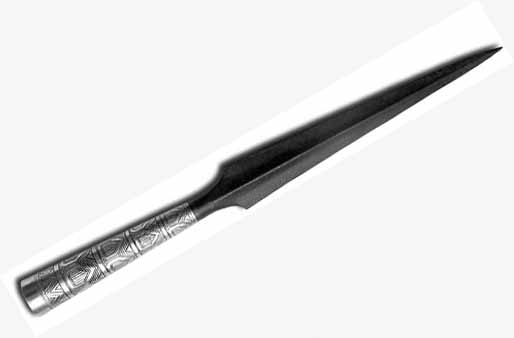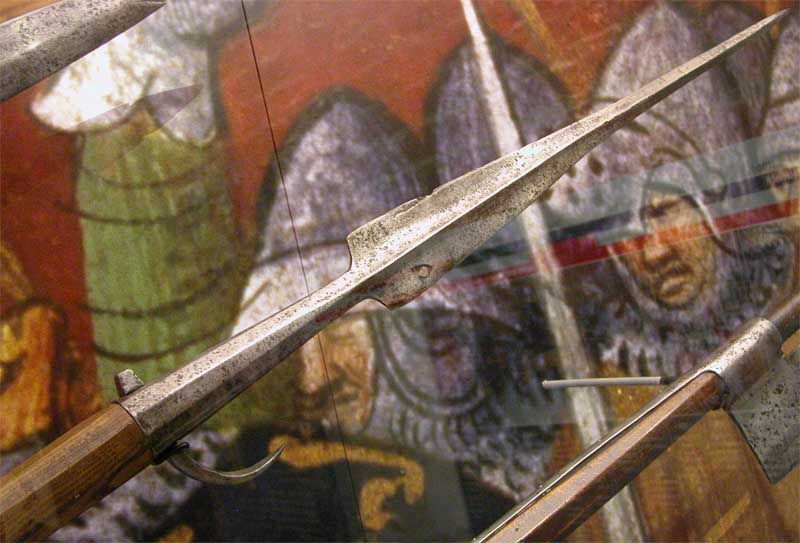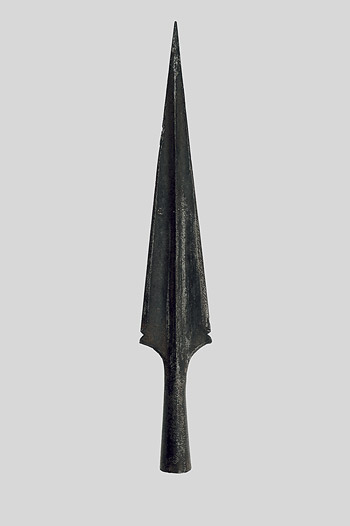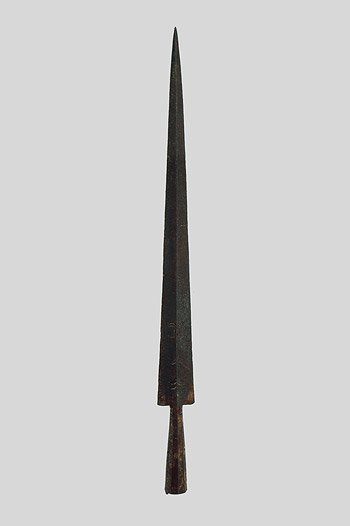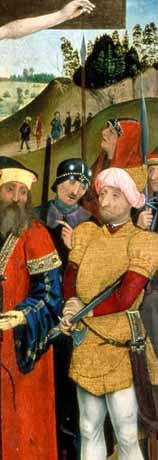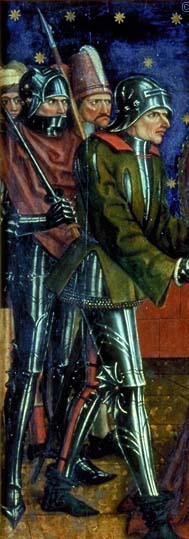Posts: 5,981 Location: Birmingham, Alabama
Thu 18 Oct, 2007 8:35 am
Spear Brainstorm
Posts: 92 Location: Seattle Metro Area, USA
Thu 18 Oct, 2007 1:10 pm
From just looking at the pictures, I'd say that you could. The hanwei does look quire similar to the period example you have. Really the only thing making it "viking" is the decorative work on the socket.
Posts: 337 Location: Houston, Texas
Thu 18 Oct, 2007 2:11 pm
| Michael Ekelmann wrote: |
| From just looking at the pictures, I'd say that you could. The hanwei does look quire similar to the period example you have. Really the only thing making it "viking" is the decorative work on the socket. |
It'll be ashame to sand off all that nice decorative work though. But all n all, I'd say you have a match.
Posts: 5,981 Location: Birmingham, Alabama
Fri 19 Oct, 2007 6:38 am
| Gary A. Chelette wrote: |
It'll be ashame to sand off all that nice decorative work. |
That's the fun part! :lol:
Posts: 264 Location: Janesville, WI
Fri 19 Oct, 2007 8:29 am
I am eagerly looking forward to seeing what you do for the hook. I love that piece and thing its a great fit for the Hanwei viking spear.
Posts: 2,121 Location: Northern Utah
Fri 19 Oct, 2007 9:24 am
GEt over to a hardwarestore adn see what type of coat hooks they have..... you may be able to then get some bar stock, hammer one end squarish then peen it into the bottom of the hook? You'd need an angle grinder to grind the hook down.
RPM
Posts: 5,981 Location: Birmingham, Alabama
Mon 22 Oct, 2007 9:37 am
I'm wondering if that huge rivet block is just a nut/peen block. Some of those large sallet rivets are made by passing a thinner shank through the formed block, then peening that small shank. I could make the block out of square stock. I think I could make the hook out of round stock, tapered to a point, then ground halfway through to make the hook and further ground to make the shank that passes through the socket and block. May be more trouble than it's worth!
Posts: 1,757 Location: Storvreta, Sweden
Mon 22 Oct, 2007 10:26 am
| Sean Flynt wrote: |
| I'm wondering if that huge rivet block is just a nut/peen block. Some of those large sallet rivets are made by passing a thinner shank through the formed block, then peening that small shank. I could make the block out of square stock. I think I could make the hook out of round stock, tapered to a point, then ground halfway through to make the hook and further ground to make the shank that passes through the socket and block. May be more trouble than it's worth! |
On the hook:
-Yes that would be the way to do it: shape it from round or square stock, forge or grind down a shank that passes through the socket and rivet against a rivet block shaped like a tapered dice. Pretty straight forward.
The "too much than it´s worth" apsect in this project would be that a viking trowing spear is about half the size of that 15th C war spear. (please note: I have not seen the production spear featured in this thread and do not know its size)
Those 15th C war spears I´ve seen are about 50 cm long from socket to point. They can be bigger or slightly smaller. They do not really compare to viking spears, other than the fact both types have a pronounced midrib. Few viking spears are this big, even though you do find occasional large heads. Those are lances and not throwing spears, of course.
A viking thorwing spear is a thick but narrow and light litte thing. Like a small but stout dagger set on a socket. The socket is dimensioned for a shaft that is slim as well (12-14 mm). Such a shaft would not work well as a two handed staff weapon.
Again, I do not know the dimensions of the Chinese replica, but if it is anywhere close to an original viking throwing spear, it would be diminutive compared to a hefty war spear of the type you want to reproduce.
I think that is where you´ll run into problems.
Sorry to be a dream crusher, but sometimes size does matter.
;)
Posts: 5,981 Location: Birmingham, Alabama
Mon 22 Oct, 2007 10:46 am
Thanks, Peter!
Size was a concern for me as well, which is why I was surprised to see that the "Viking Throwing Spear" is 40 cm! That might put the repro in acceptable range for a 15th c. spear. For once, a manufacturer's poor research serves my purpose!
The subtleties of section are another matter. The original shown above has a tip of square section, while the repro tapers uniformly to the point. It's hard to tell from photos whether or not the repro will be of convincing thickness for those robust 15th spears. Anyway, I figured it would be worth a try for $30.
I used to have a nice little collection of 15th spear photos, mostly from Czerny's, but can't find them. :(
Posts: 5,981 Location: Birmingham, Alabama
Mon 22 Oct, 2007 11:09 am
Posts: 165 Location: Southeastern Pennsylvania
Mon 22 Oct, 2007 6:01 pm
Sean,
If you were to write a reference book (ideally rich with photos) on how to turn these sow's ear weapons into the silk purses I've seen you create in these forums, I would buy that book in a heartbeat. I'm looking forward to seeing what you come up with this time.
Best of luck!
David
Posts: 255 Location: WV
Mon 22 Oct, 2007 6:29 pm
Sean,
I own a couple of these Hanwei spears. One thing to note which is not visible in the stock photos is that the socket on all of them is split up the backside almost to where the blade starts. Here is a pic of what I'm talking about
Nathan
 Attachment: 75.74 KB
Attachment: 75.74 KB
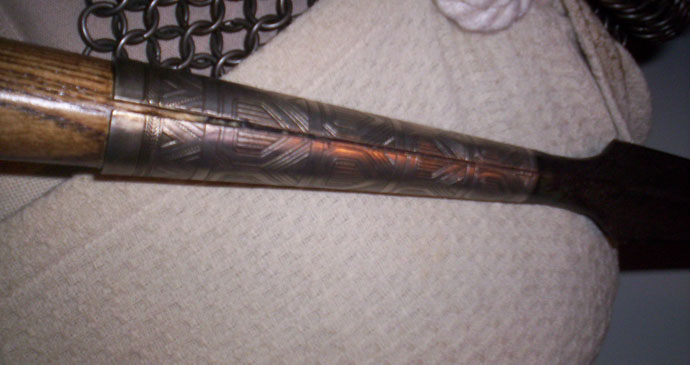
Posts: 165 Location: Southeastern Pennsylvania
Tue 23 Oct, 2007 5:25 am
That's quite a seam there. Thanks for posting that photo, Nathan. I was considering a Hanwei spear, but now I think I'll pass.
Sean: Have you considered the MRL Viking Hewing Spear for this project?
Posts: 9,570 Location: Dayton, OH
Tue 23 Oct, 2007 5:52 am
| Nathan Keysor wrote: |
Sean,
I own a couple of these Hanwei spears. One thing to note which is not visible in the stock photos is that the socket on all of them is split up the backside almost to where the blade starts. Here is a pic of what I'm talking about
Nathan |
I've seen historical spears with splits (somtimes large and sometimes crudely done) in their sockets. The concept is certainly historical.
Posts: 337 Location: Houston, Texas
Tue 23 Oct, 2007 6:56 am
If you really wanted to, a weld job could fix this and make it look better and be stronger. Since you are going to sand away all that nice inlay work, that should be acceptable.
I'd use a MIG welder to do it fast and clean if you have access to one.
Posts: 5,981 Location: Birmingham, Alabama
Tue 23 Oct, 2007 6:56 am
Yeah, the seam doesn't bother me too much. I'd rather it be solid but as Chad notes even some late medieval spears (and beyond) had crudely-closed sockets, as did some polearms. The main thing to do with this piece is to keep it rather plain. I wouldn't expect to see an open seam on a finer weapon of this period. It's a "munition"-grade spear as far as I'm concerned, and that may even argue against the elaborate rivet and faceted socket. I'll just have to see what looks appropriate when it arrives. Mine may end up looking like this one:
 Attachment: 18.43 KB
Attachment: 18.43 KB

Last edited by Sean Flynt on Tue 23 Oct, 2007 7:35 am; edited 2 times in total
Posts: 5,981 Location: Birmingham, Alabama
Tue 23 Oct, 2007 6:58 am
It's all here! You get it for free!
| David Martin wrote: |
Sean,
If you were to write a reference book (ideally rich with photos) on how to turn these sow's ear weapons into the silk purses I've seen you create in these forums, I would buy that book in a heartbeat. I'm looking forward to seeing what you come up with this time.
Best of luck!
David |
Posts: 5,981 Location: Birmingham, Alabama
Tue 23 Oct, 2007 7:31 am
Posts: 5,981 Location: Birmingham, Alabama
Thu 25 Oct, 2007 9:45 am
I now have the spearhead in hand, and I can report that although it's a very attractive piece, it will be a bit too light and narrow to represent the robust infantry spear pictured in my original post. However, it should work perfectly for the last antique spearhead I posted above. That's my new target. Sorry, folks--no funky hook-rivet this time!
FYI: This spearhead is of two-piece cast construction. The socket appears to be plated with a silver-like metal. This is scraped off relatively easily, revealing a layer of copper beneath. This scared me, at first, because I thought the entire socket might be plated copper, but a little more scraping revealed steel beneath the copper. Hmmm...and....yes, I've just stuck the head to the side of my iMac :lol: and the internal magnet confirms that both blade and socket are steel.
This is a very nice item, well worth the $30 I paid for a pre-owned one or even the full price of ca. $45. Should be good to represent spears from a variety of periods (just not an a "Viking throwing spear," I guess. :D).
Posts: 5,981 Location: Birmingham, Alabama
Fri 18 Jan, 2008 6:46 am
You
cannot post new topics in this forum
You
cannot reply to topics in this forum
You
cannot edit your posts in this forum
You
cannot delete your posts in this forum
You
cannot vote in polls in this forum
You
cannot attach files in this forum
You
can download files in this forum
